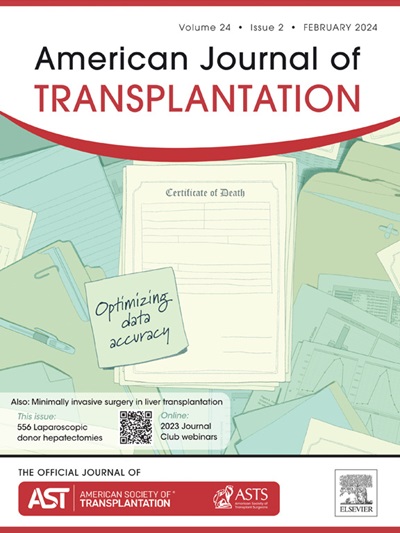Donor-derived cell-free DNA is associated with the degree of immunosuppression in lung transplantation
IF 8.2
2区 医学
Q1 SURGERY
引用次数: 0
Abstract
Donor-derived cell-free DNA (ddcfDNA) is increasingly used in clinical practice to monitor lung transplant patients for acute rejection (AR). However, its association with conventional approaches to monitor immunosuppression remains unclear. This multicenter observational cohort study examines the association of ddcfDNA with surrogate measures of immunosuppression. We collected serial plasma samples to quantify ddcfDNA and anellovirus abundance using shotgun and metagenomic sequencing. Adjudication committees reviewed clinical data to define acute cellular and antibody-mediated rejection. The association between ddcfDNA, anellovirus abundance, and tacrolimus trough concentrations in serum over the study period and during episodes of AR was examined using linear mixed-effects modeling. ddcfDNA demonstrated a significant inverse association with tacrolimus troughs (P = .027) and anellovirus abundance (P < .001) over time. AR episodes were associated with significantly decreased anellovirus abundance (median, 0.042 vs 0.708, P < .001) and higher ddcfDNA levels (1.49% vs 0.26%, P < .001) compared with stable control time points. However, tacrolimus levels were similar between AR and controls (10.1 vs 10.3 ng/mL, P = .13). Our findings suggest ddcfDNA correlates with measures of immunosuppression in lung transplant patients. Additional studies are needed to assess the utility of ddcfDNA to assess immunosuppression adequacy.
供体来源的无细胞DNA与肺移植中免疫抑制的程度有关。
在临床实践中,越来越多地使用供体来源的无细胞 DNA 来监测肺移植患者的急性排斥反应。然而,它与常规免疫抑制监测方法之间的关系仍不清楚。这项多中心观察性队列研究探讨了供体细胞游离 DNA 与免疫抑制替代指标之间的关系。研究人员采集了连续血浆样本,通过霰弹枪测序和元基因组测序对供体来源的游离细胞 DNA 和anellovirus 丰度进行量化。评审委员会对临床数据进行审查,以确定急性细胞和抗体介导的排斥反应。通过线性混合效应模型研究了研究期间和急性排斥反应发作期间ddcfDNA、anellovirus丰度和血清他克莫司谷浓度之间的关系。随着时间的推移,捐献者来源的无细胞DNA与他克莫司谷浓度(p=0.027)和无病毒丰度(p<0.001)呈显著的反向关系。与稳定对照时间点相比,急性排斥反应与anellovirus丰度显著下降(中位数,0.042 vs. 0.708,p<0.001)和ddcfDNA水平升高(1.49% vs. 0.26%,p<0.001)有关。然而,急性排斥反应和对照组的他克莫司水平相似(10.1 ng/ml vs 10.3 ng/ml,p = 0.13)。我们的研究结果表明,供体来源的无细胞DNA与肺移植患者的免疫抑制指标相关。还需要更多的研究来评估供体来源的无细胞DNA在评估免疫抑制是否充分方面的作用。
本文章由计算机程序翻译,如有差异,请以英文原文为准。
求助全文
约1分钟内获得全文
求助全文
来源期刊
CiteScore
18.70
自引率
4.50%
发文量
346
审稿时长
26 days
期刊介绍:
The American Journal of Transplantation is a leading journal in the field of transplantation. It serves as a forum for debate and reassessment, an agent of change, and a major platform for promoting understanding, improving results, and advancing science. Published monthly, it provides an essential resource for researchers and clinicians worldwide.
The journal publishes original articles, case reports, invited reviews, letters to the editor, critical reviews, news features, consensus documents, and guidelines over 12 issues a year. It covers all major subject areas in transplantation, including thoracic (heart, lung), abdominal (kidney, liver, pancreas, islets), tissue and stem cell transplantation, organ and tissue donation and preservation, tissue injury, repair, inflammation, and aging, histocompatibility, drugs and pharmacology, graft survival, and prevention of graft dysfunction and failure. It also explores ethical and social issues in the field.

 求助内容:
求助内容: 应助结果提醒方式:
应助结果提醒方式:


